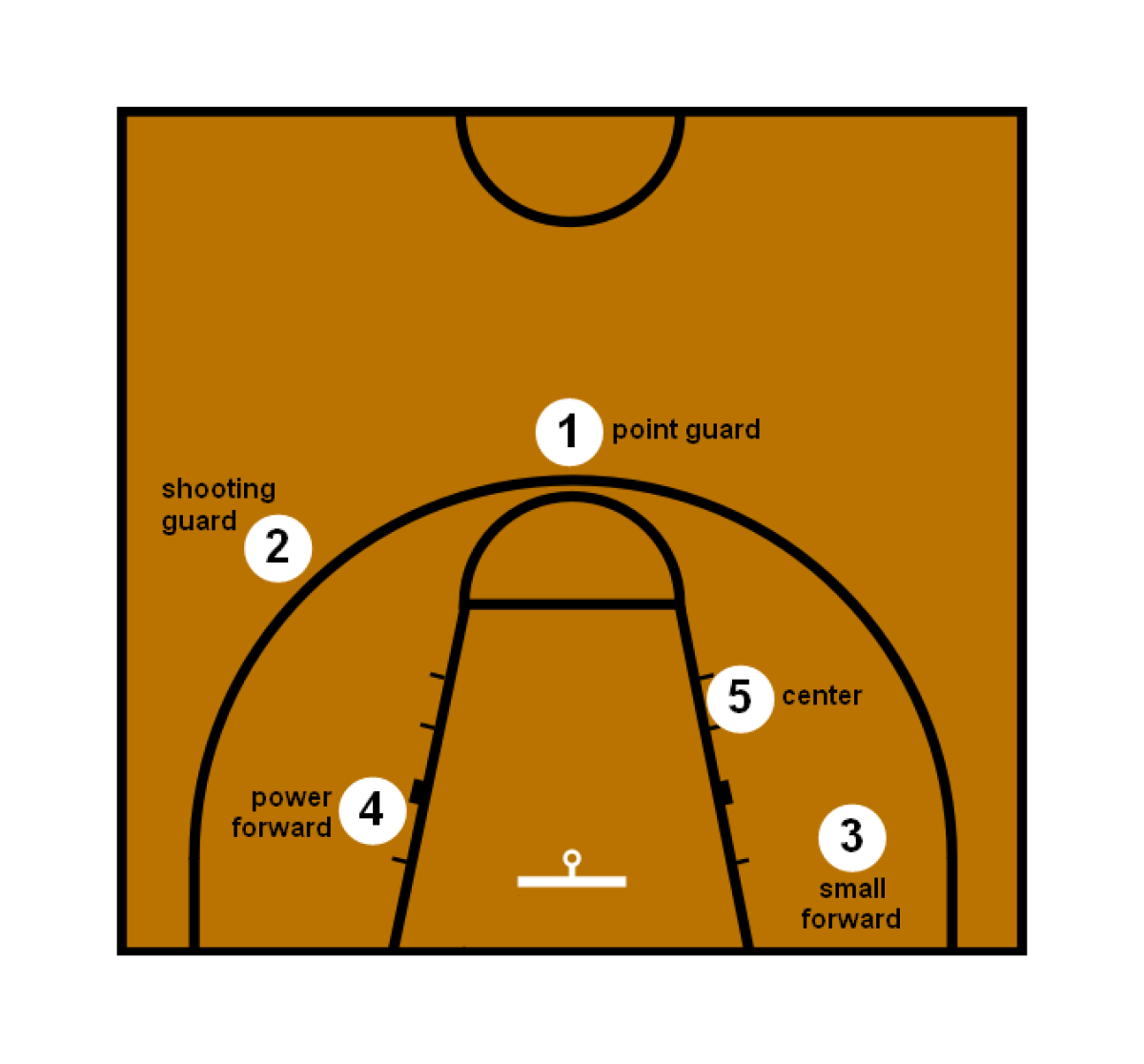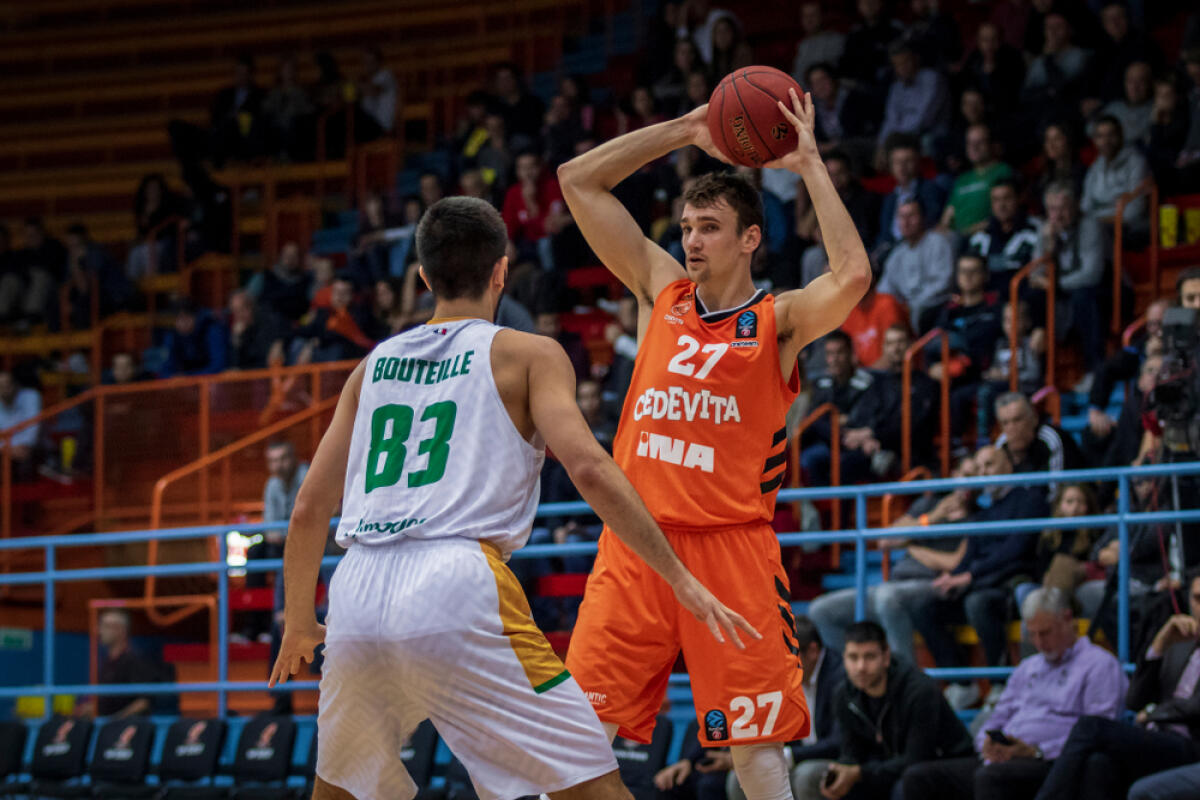Basketball Positions and Key Roles of the Players
The five traditional basketball positions are point guard, center, shooting guard, small forward, and power forward. However, roles in basketball are evolving.
Basketball Positions and Roles
In a basketball game, each team has five players on the court. Every player is assigned one of five basic positions, and with that position comes a specific set of responsibilities that each player needs to fulfill.
These five basic positions are point guard, shooting guard, small forward, power forward, and center.
However, like every sport, basketball has evolved considerably over time, and now, it is common to see players who are able to adapt quickly to different roles and excel in different positions, according to the needs of their team.
Here, we describe both: the basic basketball positions and the recently created “hybrid” positions.
Basic Positions In Basketball
- Point Guard
- Shooting Guard
- Small Forward
- Power Forward
- Center
- Combo Guard
- Stretch Four
- Swingman
- Point Forward

Point Guard

The point guard is the strategic visionary of the team, the one in charge of directing the game and deciding which plays to execute.
As a comparison, a point guard is to basketball what a quarterback is to football, commanding the team’s offensive line and driving the ball up the court.
However, the point guard needs to be equally adept at defensive plays. It is very common to see the point guard stealing the ball or forcing a turnover.
Physically, point guards tend to be short and light (by basketball standards, although there are exceptions) and are very quick and agile.
Who is the tallest female basketball player in WNBA history?
Point guards also need to be team players, as one of their key responsibilities is to get the ball to the right player at the right time. As the strategic head of the team, they also need to communicate constantly with their teammates.
These key abilities define a point guard:
- Dribbling
- Stealing
- Passing
- Play selection
Point guards usually lead the scoreboard in steals and assists, and some, like Stephen Curry, can be extraordinary shooters.
Besides Curry, some of the most successful point guards are Steve Nash, John Stockton, Magic Johnson, and Chris Paul.
Shooting Guard
Also known as the “two guard”, the shooting guard is the team’s best outside shooter, and therefore, the top choice for taking three-point shots.
Beyond three-pointers, the shooting guard is a consistent scorer, combining mid-range shots with layups, floaters, and other scoring plays in close range.
Therefore, they are likely to lead the league in the points department.
Even though their main attacking responsibility is to make baskets, the shooting guard also needs to be a good ball handler and strategic playmaker to be able to act as a backup stage director to the point guard.
Defensively, the shooting guard is required to have good mobility, anticipate plays and make steals, and get rebounds to recover the ball. Some shooting guards, like Kobe Bryant and Dwayne Wade, excelled at blocking.
Kobe and Wade aside, some of the most celebrated shooting guards are Michael Jordan, Reggie Miller, and Klay Thompson.
Small Forward
The small forward is the most versatile player on the team.
Small forwards combine the speed and agility of a shooting guard with the strength and power of a power forward. They are easily adaptable and can cover multiple positions as needed.
Offensively, the small forward needs to be dynamic enough to shift from scoring three-pointers to making dunks. They are likely smaller in size than power forwards, but they still need to have enough strength to play in the paint.
Because of their wide array of skills, small forwards are usually considered the best all-around players.
Defensively, the small forward is tasked with getting rebounds, supporting the guards in covering dangerous opponents, and playing efficiently in the key by blocking the power forward.
The perfect example of a small forward is LeBron James, and other noteworthy small forwards are Kevin Durant and Larry Bird.
Power Forward
The power forward is a physically strong player who is frequently inside the three-point line. Power forwards tend to be tall and usually intimidate their opponents because of their size.
In the offense, the power forward will be close to the basket, where he is tasked with recovering rebounds, setting up screens to create open space for shooters, and scoring dunks, layups, and short-range shots.
An additional skill required for a power forward is a solid mid-range shot, especially jump shots.
When playing defense, the power forward is one of the most important players. One of their main tasks is to protect the biggest players (usually another power forward) and prevent them from scoring from a close range.
Since they are often located in the paint, they are responsible for recovering the ball through rebounding and blocking. When a teammate gets dribbled, the power forward can act as support for the dribbled teammate.
Power forwards play near the posts, where the game is more physical. Since this results in power forwards being fouled often, they are reliable free-throw shooters.
Some renowned power forwards are Tim Duncan, Kevin Garnett, Anthony Davis, and Giannis Antetokounmpo.
Center
Traditionally, the center is the tallest and physically strongest player on the team. The center plays under the basket and near the low post.
Offensively, the center’s main responsibilities are to get rebounds and score shots from close range. In addition to this, their physical strength assists them to create space for other players, by blocking defenders and creating screens.
Defensively, the center guards the area close to the rim. Centers are responsible for recovering the ball through defensive rebounds, blocking the opponents’ shots, and forcing them to make mistakes in the paint.
Despite their size, centers need to be very agile and have top-notch footwork, especially as the game has become more physical.
From close range, centers need to shoot quickly and make fast decisions, and having a good jump gives them an edge over their opponents, especially to score dunks.
Famous centers are Shaquille O’Neal, Wilt Chamberlain, and Joel Embiid.
Hybrid Positions
As basketball has evolved, some players have become versatile enough to be able to play in more than one position.
This has resulted in the creation of “hybrid” positions, which combine skills and physical characteristics of two or more basic basketball positions.
Modern players like LeBron James and Joel Embiid have been described as hybrids by former NBA stars.
Here’s Dirk Nowitzki, the Dallas Mavericks icon, talking to the Basketball Network about Embiid: “I feel like he’s got the body of a little smaller Shaq, but he’s got the shot from the outside. He’s got the finesse like Hakeem (Olajuwon) a little bit, the footwork.”
Similarly, Terry Porter, a former star with the Portland Trail Blazers, described LeBron James as the combination of multiple top players from his era. “I think LeBron, he has just been special in regards to how he’s been built. I wouldn’t say he’s one guy, he’s like multiple guys from my era. He’s like a Scottie Pippen and a Magic. There’s no guy in my era even close to the size, and again, my era didn’t have guys who were playing multiple positions or what they say now, non-positions and playing three, four, five spots.”
Combo Guard
The combo guard is a combination of the shooting guard and the point guard.
They have incredible ball-handling skills and can take charge of playmaking, driving the ball up the court and assisting their teammates.
Beyond this, however, they are extremely talented shooters and often lead their team in points scored.
A team could have two combo guards on the court, especially to alternate them on defensive and offensive plays.
A perfect example of a combo guard is Allen Iverson.
Stretch Four
A stretch four commonly plays as a power forward.
However, the stretch four brings the added value of being an excellent three-point shooter, which provides more options for the offensive line and “stretches” the defense.
A classic stretch-four player is Dirk Nowitzki.
Swingman
The swingman combines the talents of a small forward and a shooting guard.
Swingmans are frequently taller than shooting guards, but are equally skilled dribblers and shooters. This empowers them to play both inside and outside the perimeter, and creates more complexities for defenders.
An iconic swingman is Tracy McGrady.
Point Forward
The point forward is a player who can take on the responsibilities of a point guard and those of a small forward or power forward.
When their team has the ball, the point forward is the playmaker of the team. When on defense, the point forward is responsible for opposing the forwards.
A player who started as a small forward and evolved to a point forward is LeBron James.
Sixth Man
The sixth man is a player that starts the game on the bench and is the first substitute to come in.
Players who are considered the sixth man are versatile, highly skilled, and have a revulsive effect on their teammates, bringing an energy boost to the game.
Players who have won the NBA Sixth Man of the Year Award include Manu Ginobili, Jamal Crawford, and Toni Kukoc.
The Bench
Players who start the game on the sidelines are considered the bench.
Players are on the bench for different reasons. Some bench players, like the sixth man, could be strategic players that will play a significant amount of minutes. They will be used to change the pace of the match, depending on the needs of the team.
Other bench players are backup players, and they might not get as many minutes, unless a starting player suffers an injury or is fouled out.
Every match is different, and depending on the circumstances and the needs of the match, the coach will decide which players get more minutes.
Basketball Drills For Power Forwards and Centers
Power forwards and centers need drills that help them leverage their advantages, which are being tall and physically strong. Also, they need to practice plays near the post area, as that is usually where they are.
If you are a center or power forward, here are some drills that can help you develop your skills.
Ball Handling Drill
A popular ball-handling drill for power forwards and centers is the crab dribbling drill. It is named like this because it involves dribbling from point A to point B at the speed of a crab.
This drill, which will help you improve your ball-handling abilities, consists of making two back-down dribbles from the lower end of the court to half-court. In each dribble, you need to change the hand that you are using to spin the ball.
Finishing Drill
Centers and power forwards need to have excellent rebounding and finishing skills, especially inside the key. This drill will help you practice both.
- Throw the ball up and bounce it off the glass
- Jump to get the rebound
- Shoot to make the basket
Shooting Drill
This drill will help you polish your close-range shooting skills.
- Place yourself in a receiver position, as if facing your partner. You are facing the basket backwards.
- Pass the ball to your right hand, as your left arm is protecting the ball from the defender.
- Make a big step with your right foot to open up space, and have your left foot follow.
- Now that you are in a shooting position, make your shot.
To see these drills in action, watch this video.
Basketball Drills For Small Forwards
Small forwards thrive on versatility, therefore, they need to practice both speed and power drills.
If you are a small forward, here are some drills that can help you.
Chair Drill
- Place a chair at the point where the lane line intersects with the free-throw line
- Place another chair outside the perimeter of the three point-line
- Set a basketball on top of each chair
- Run up the lane line, and around the first chair (the one on the perimeter)
- Pick up the ball
- Shoot
- Turn around and run to the next chair
- Pick up the ball, do a rip move, and attempt a layup.
To see this drill in action, watch this video. For more drills for small forwards, go here.
Basketball Drills For Point and Shooting Guards
Some of the key abilities that guards need to work on include dribbling, shooting, and ball handling.
Here are some drills to help you work on them.
Pound Dribbling
This drill could be overestimated because of its simplicity, but it addresses a foundational skill for all guards.
- Start the ball on your fingertips and ensure to keep the ball below your waist.
- Pound the ball up and down, while keeping the rest of your body quiet.
Watch the drill here, and if you want to learn more about dribbling fundamentals, NBA legend Isaiah Thomas explains them here.
Fast Break
Driving the ball up the court is a fundamental ability for a guard. This fast-paced drill developed by Joe Haefner combines dribbling and ball handling with speed and sprinting abilities that are necessary to move your team forward. Watch it here.
Creating Space
As a playmaker, your job is to open up the space for your team to score. Whether you take the shot as a shooting guard or make the assist as a point guard, moves that create space will greatly serve you on the court. Practice these 4 drills by Coach Tony that are likely to mislead your opponents and give you the necessary space on the court.
Final Thoughts
Like everything, positions in basketball have evolved significantly over time. This means that aspiring basketball players need to be highly adaptable and agile. The future league stars will be the players who can develop themselves as all-around players, and who can read and understand different game situations.
However, there are fundamentals to each of the positions described that will keep being important, and players need to understand what their strengths and weaknesses are to see where they fit best.
Basketball Positions FAQs
Which basketball position scores the most?
Traditionally, the small forward and the shooting guard tend to be the highest scorers.
Where is the post position?
The post is the area covered between the free throw line and the baseline. It is also known as the key or the paint.
Which is the most important basketball position?
Although there is debate about this, the point guard is considered the leader and playmaker of the team, the equivalent of a quarterback in the NFL.
What are the numbers assigned to each basketball position?
1 = Point Guard. 2 = Shooting Guard. 3 = Small Forward. 4 = Power Forward. 5 = Center.
What are the five basketball positions?
The five basketball positions are point guard, shooting guard, small forward, power forward, and center.
Our editorial content strives to be highly informative and educational to our audience, especially for visitors who are new or relatively new to analyzing and predicting sporting event results. All of our content is created by informed writers with backgrounds in their subject area and reviewed for omissions or mistakes.
Our editorial team is run by individuals with many years of experience in digital publishing, editorial, and content production. Our editorial content is always marked clearly in any instances where it may be sponsored by a third party, though it is still reviewed by our staff to ensure it remains consistent with our company mission.
- Popular
- Latest







